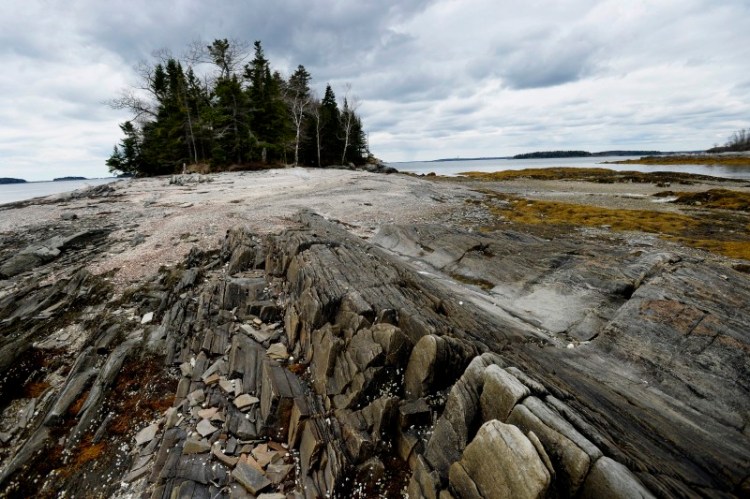Before the sun rises over a neighboring island, a translucent plum of moon slips into clouds tinged pink with the approaching day. The full moon has drawn the tide to an astronomical low, revealing a lunar-like landscape of barnacle-encrusted ledges rarely visible. This unexpected, sub-tidal terrain, tranquil in the pause before dawn, offers a glimpse into the mystery that swirls beneath the surface of our everyday lives.
Time on Maine’s wild islands reawakens all our senses, but most especially the sense of wonder. These islands brim with elemental power, heart-stopping beauty and mind-bending paradox. Only in two-dimensional pictures are these islands static. In real time, they are dynamic collages – continuously evolving in response to geological forces, climatological trends and planetary polarities.
Rocks forged from volcanic lava carry the chisel marks of glacial ice. Restless waters that have long been rising lap at former mountain summits. The contours of beaches and tidal bars can shift dramatically from season to season and year to year. Fog and tides make a watercolor wash of the islands’ edges, blurring the parameters of place.
When you’re immersed in this elemental flux on islands, time and space have a way of warping before your eyes. Life feels less linear and more cyclical. It’s as if you enter a deeper timelessness, joining into natural rhythms far older than clock-driven chronology. Even as islands set limits on where you can go and what you can experience, they expand your perspective. Celtic mythology acknowledges the sacred value of places where “the veil between worlds” is thinnest – inviting glimpses into a universe of greater mysteries.
Bounded ecosystems also invite us into closer relations with neighboring species. Islands commonly called “uninhabited” turn out to be vibrant communities of plants and animals going about their essential life tasks – feeding, mating, nesting, raising young, blooming, going to seed, sending out runners, putting down roots. And doing so against great odds. Organisms thrive in an intertidal zone marked by harsh extremes and scouring wave action, while plants gain a foothold on the thin soil that sits atop bedrock. This recognition of a shared hunger for life led Albert Schweitzer to his philosophy of Reverence for Life – the transformative acknowledgement that “I am life that wills to live in the midst of life that wills to live.”
There’s an endless interplay among island species as they seek to establish and hold their ground. Year to year, the shifting dynamics are evident as juniper overtakes goldenrod; ospreys and bald eagles vie for nesting territory; and aging spruce trees give way to red elderberry and raspberry bushes. Less apparent to the untrained eye are a whole host of changes that could have profound effects on these refuges of life perched at the edge of the sea. What will acidifying oceans do to surrounding clam and mussel beds? How will rising ocean temperatures affect the plankton and fish that support so many species? What will happen to low-lying seabird nesting islands as ocean levels rise? Already, the astronomical “King Tides” swallow some beaches whole, dousing the bordering wild roses with a killing dose of salt.
Because there is no “away” on islands, we see more readily the impacts of our actions, and the ways in which our fate is inextricably bound to the health of the whole ecosystem. The intimacy of island life reminds us, as Richard K. Nelson writes in “The Island Within,” that “we share in a common nurturing.” This basic ecological insight – so readily forgotten in mainland life – forms the essence of island consciousness. For better or worse, richer or poorer, in sickness or in health, we are partners in place. On islands, that conviction of belonging is as real and non-negotiable as the weather.
In a world of increasingly fast-paced and far-reaching technology, islands offer a grounding foothold where we can rediscover our place in the world. Bounded on all sides by sea, far removed from the distractions of mainland life, we find a surprising richness of being. In the company of chortling eiders, raucous young crows and fragrant bayberry, we rediscover the joy of living with senses wide open. The most profound paradox of island life, it seems, is how much we receive from the gift of limits.
Send questions/comments to the editors.



Success. Please wait for the page to reload. If the page does not reload within 5 seconds, please refresh the page.
Enter your email and password to access comments.
Hi, to comment on stories you must . This profile is in addition to your subscription and website login.
Already have a commenting profile? .
Invalid username/password.
Please check your email to confirm and complete your registration.
Only subscribers are eligible to post comments. Please subscribe or login first for digital access. Here’s why.
Use the form below to reset your password. When you've submitted your account email, we will send an email with a reset code.